Shimano GRX Di2 12-speed Drivetrain
Test Duration: 3 months
Test Locations: Western Washington
Blister’s Measured Weight:
- ST-RX825 levers: 220 g (each)
- BR-RX820 brake caliper: 172 g (each, w/ hose)
- RT-CL800 rotors: 120 g (each)
- RD-RX825 rear derailleur: 310 g
- FD-RX825 front derailleur: 138 g
- RX820 crankset: 720 g (48/31T, 172.5 mm arms)
- CS-R8101 cassette: 339 g (11-34T)
- CN-M8100 chain: 283 g (uncut)
- BT-DN300 battery: 52 g
- EW-SD300 wire kit: 18 g
- SM-BBR60 bottom bracket: 67 g (BSA threaded)
- WH-RX880 front wheel: 659 g
- WH-RX880 rear wheel: 777 g
MSRP:
- GRX RX825 group: $2,533.87 USD (full group including chain, cassette, battery, wires, and brake calipers and discs)
- GRX SPD M8100-UG pedals: $138.00 USD
Bolted To: Orbea Terra M-TEAM
Reviewer: 6’, 165 lb / 183 cm, 74.8 kg
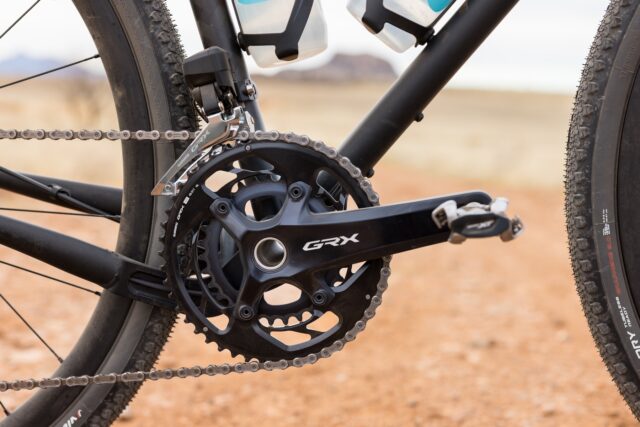
Intro
The battle of the electronic drivetrains continues, and while SRAM remains alone among the two Big S brands in offering a fully wireless option, Shimano is pushing the evolution of their time-tested Di2 drivetrains. Having launched 12-speed options for the mechanical GRX groups just last year, Shimano is now updating their Gravel-specific GRX Di2 drivetrain with a 2 x 12 option — RX825.
The big news is that, as with its latest Dura-Ace, Ultegra, and 105 Di2 Road drivetrains, the new RX825 lineup is now semi-wireless. That means wireless levers for much easier setup, while the rear derailleur and front derailleur still share wired connections to the central battery mounted in the frame.
There’s quite a bit here, so let’s dive into the details of the new RX825 lineup.
GRX ST-RX825 Hydraulic Disc Brake Dual Control Lever
MSRP: $556.99 USD (price includes BR-RX820 brake caliper)
Stated Weight: 830 g / pair (including brake calipers and hoses)
The updated ST-RX825 levers are the heart of Shimano’s new GRX Di2 system. The hoods feature some familiar details from the outgoing 11-speed GRX RX815 Di2 levers, such as a textured rubber pattern on the hoods and anti-slip coating on the levers for a more secure grip in rough terrain. The shift buttons are positioned on the sides of the lever for similar ergonomics to Shimano’s non-Di2 drivetrains, but the levers also get a third Di2 button on the inside of the hood which can be customized to the rider’s function of choice. We’ll talk more about all of the programmable customization options in a bit.
Shimano also says that they’ve updated the lever ergonomics for a Gravel-specific fit. As part of those updates, the ST-RX825 levers supposedly interface better with flared drop bars, which is great to see — as someone who has spent a lot of time on the GRX RX800 mechanical drivetrain but also prefers the fit of flared bars, I definitely saw room for ergonomic improvement there.
Of course, the biggest update here is the wireless communication from the shifters to the derailleurs. While Shimano’s older Di2 systems were a bit fussy to set up due to the required junction boxes hidden in the frame, the new wireless arrangement means that the only thing physically connected to the levers are the brake hoses.
As a final note, Shimano prices the levers with GRX BR-RX820 brake calipers. While precedent would suggest that Shimano will sell the lever sans brake caliper, we don’t have prices for the a-la-carte option just yet.
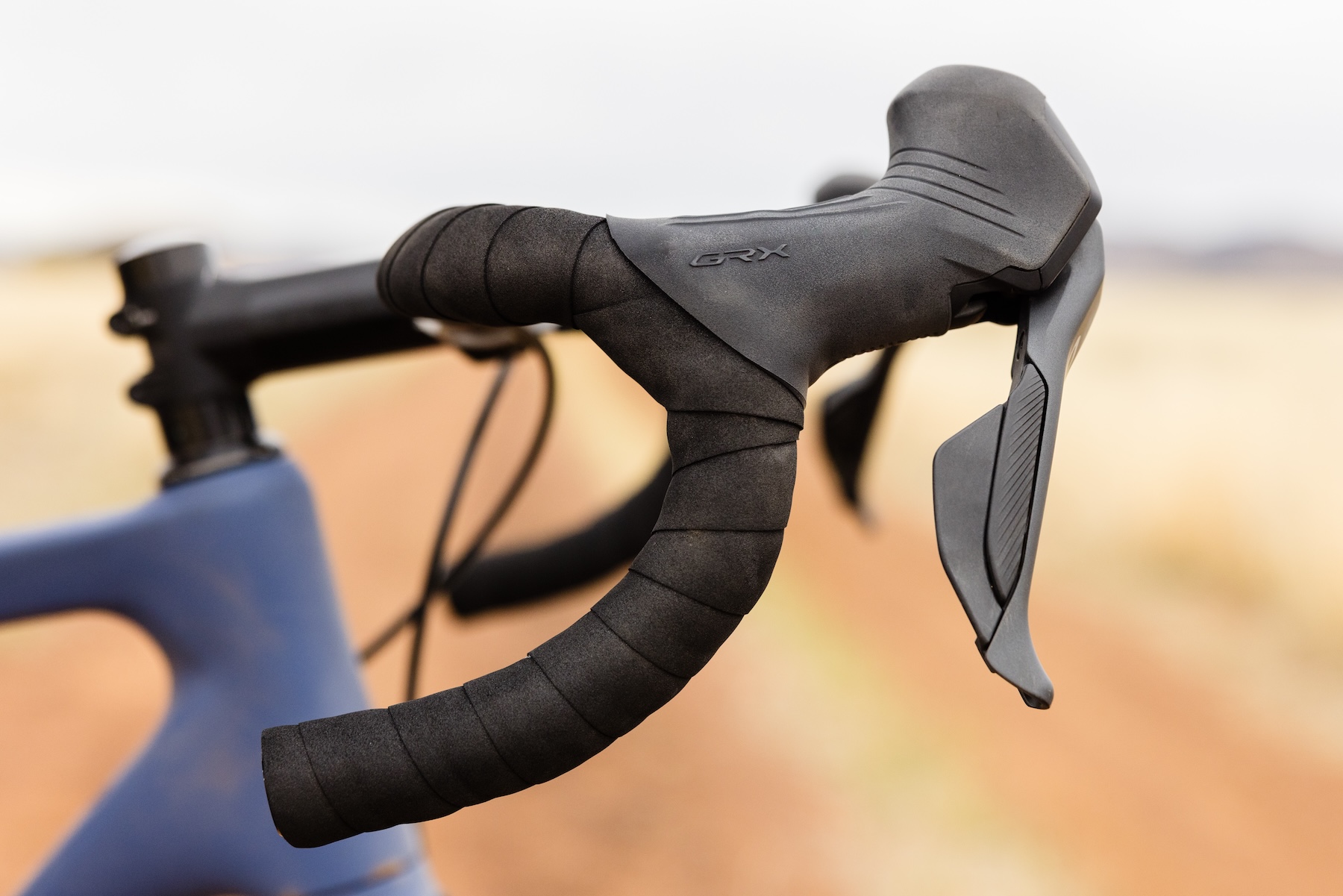
GRX RX-825 Rear Derailleur
MSRP: $409.99 USD
Stated Weight: 310 g
With the levers now wireless, the RD-RX825 derailleur is now the central communication hub for the drivetrain. With the battery mounted separately in the frame, the rear derailleur serves as the charging port for the system via its wired connection to the battery. A button on the rear derailleur allows riders to check battery level, pair via Bluetooth, or go into trim adjustment mode for aligning both front and rear derailleurs.
Outside of those electronic functions, the RD-RX825 gets a lot of other familiar Shimano features like Shimano’s SHADOW RD+ layout which tucks the derailleur somewhat inboard for a lower profile while also having a clutch for chain stabilization.
From a compatibility standpoint, the new 12-speed derailleur can be used with 11–34T and 11–36T cassettes.
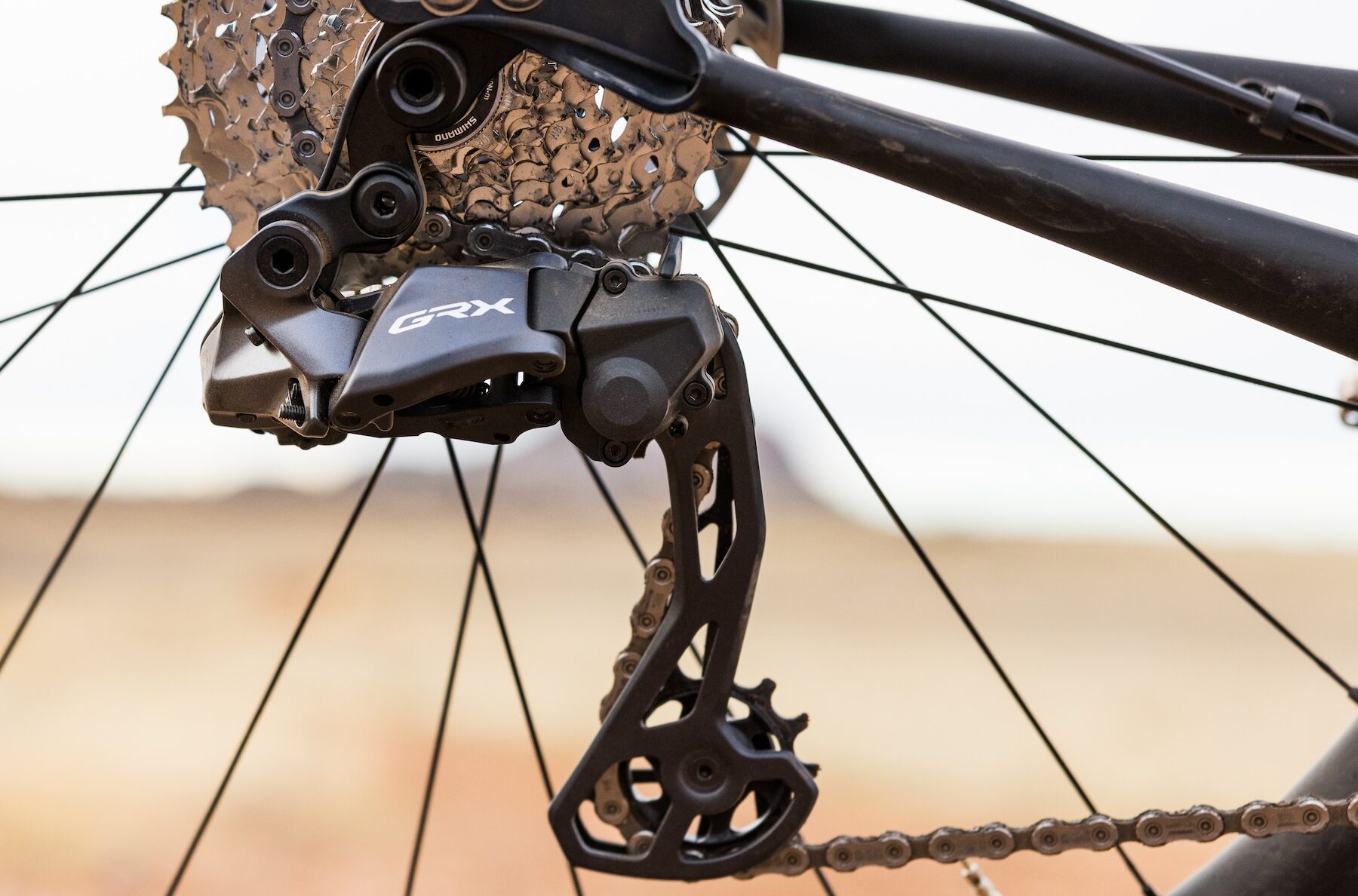
GRX FD-RX825 Front Derailleur
MSRP: $209.99 USD
Stated Weight: 142 g
Like the rear derailleur, the GRX Di2 front derailleur is wired up to the central battery. This does mean a bit of work routing the small wires during setup, but also means that only a single shared battery needs to be charged between both derailleurs.
Shimano’s earliest GRX groups ran a slightly wider +2.5 mm chainline for better tire clearance, and though the last couple of iterations walked that back to conventional Road spacing, the new GRX Di2 12-speed sees a return to the 2.5 mm wider stance. Gravel bikes are seeing wider tires being used for a more comfortable ride in rough terrain, and the added clearance from the chainline helps mitigate any potential clearance issues.
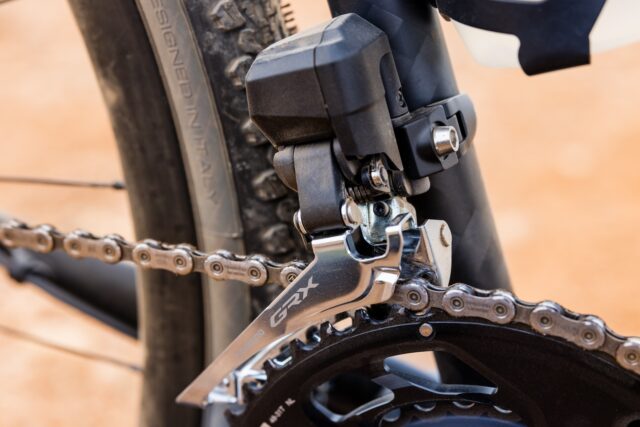
GRX SPD M8100-UG Pedals
MSRP: $138.00 USD
Stated Weight: 342 g
Along with the new RX825 Di2 group, Shimano is also releasing a limited edition pedal in the M8100-UG. The pedals are the same as Shimano’s smaller-bodied Deore XT M8100 pedals, but get special United in Gravel graphics for the Gravel crowd.
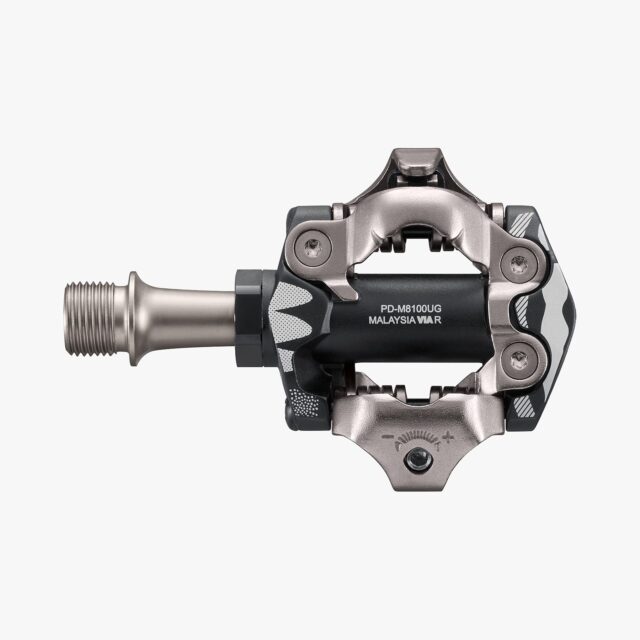
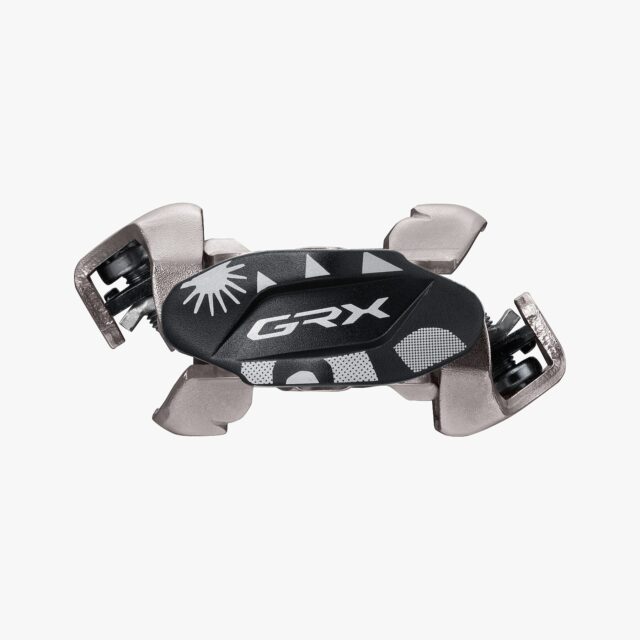
Customization
Of course, one of the big selling points of an electronic system is the huge range of customization in shifting options. Using Shimano’s E-TUBE PROJECT Cyclist app, riders can customize shift button arrangements, select different gear shift intervals for each button, program auto-shift modes that synchronize front and rear derailleur shifting, and fine-tune derailleur alignments.
The Bluetooth compatibility of the ST-RX825 lever means that riders can also control accessories such as compatible cycling computers. The shifters are also compatible with accessory switches, which can be added as a satellite switch in a place of the rider’s choice for controlling shifting, computers, or compatible lights.
Shimano has also announced a feature update for Di2 to coincide with the RX825 launch — Front Shift Next. A firmware update allows any 12-speed Di2 button to be programmed to shift the front derailleur to the unused front chainring. This allows simpler flipping between front chainrings while relying on a single button, and frees up another button for other shifting customization options, or controlling a cycling computer or compatible lights.
Compatibility
GRX RX825 is compatible with the 48/31T RX820 or 46/30T RX610 cranksets, and works with the 11–36T HG710 or 11–34 R9200, R8100, or R7100 cassettes. Shimano makes 3 different freehub spline systems across MTB and Road, including Micro Spline, HG spline L2 (12-speed Road), and HG spline L (12/11-speed Road), all of which have varying levels of compatibility based on the cassette type chosen. The chart below helps to explain further, but implies that 11-speed cassettes can be used by installing a 1.85 mm spacer, and of course programming the Di2 system to recognize 11 rather than 12 speeds.
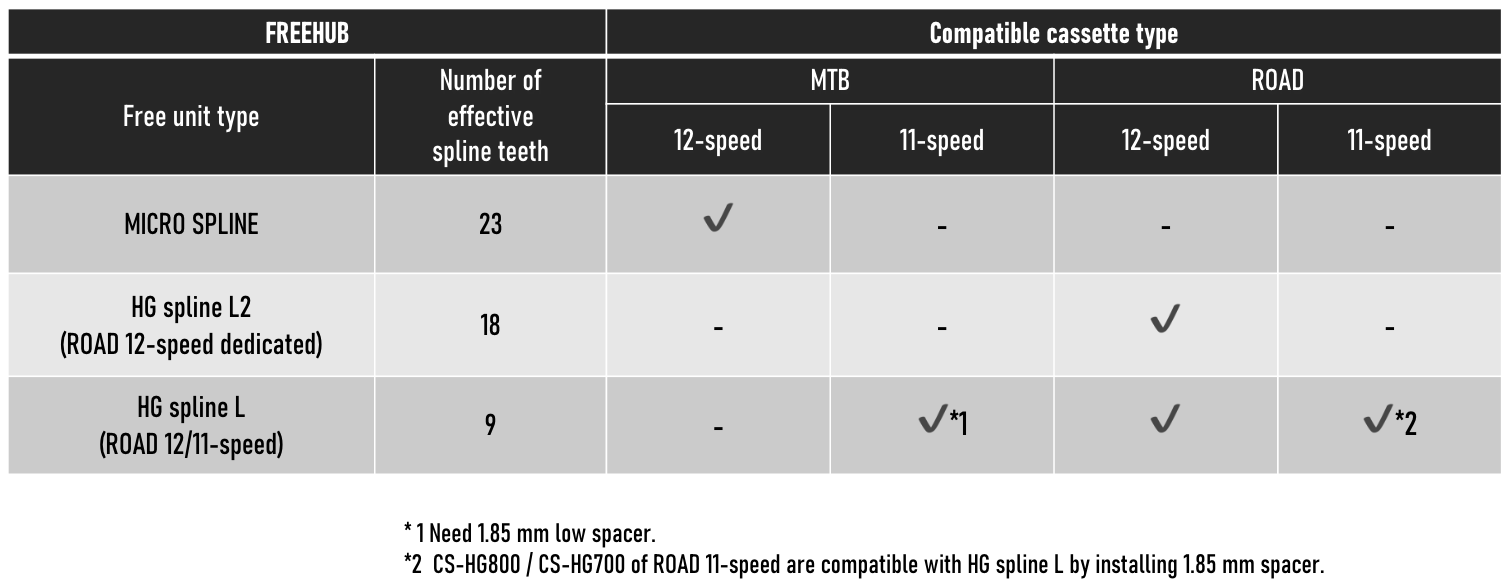
FULL REVIEW
The first version of Shimano’s Di2 was first spotted back in 2001 with the comfort-oriented NEXAVE C910 group, but became more mainstream with the 10-speed Dura-Ace group released in 2009 — a whopping 15 years ago. While another certain S-brand has recently made wireless electronic shifting a common sight across cycling disciplines, Shimano has been more hesitant to adopt the fully wireless arrangement, with recent Di2 groups getting wireless shifters while sticking with a central battery with a wired connection to the derailleur(s).
Shimano claims many benefits to the semi-wireless approach — but what’s it actually like to live with? We have been logging quite a few miles on the Di2-equipped GRX RX825 drivetrain, Shimano’s semi-wireless 2 x 12 Gravel group, and are ready to weigh in.
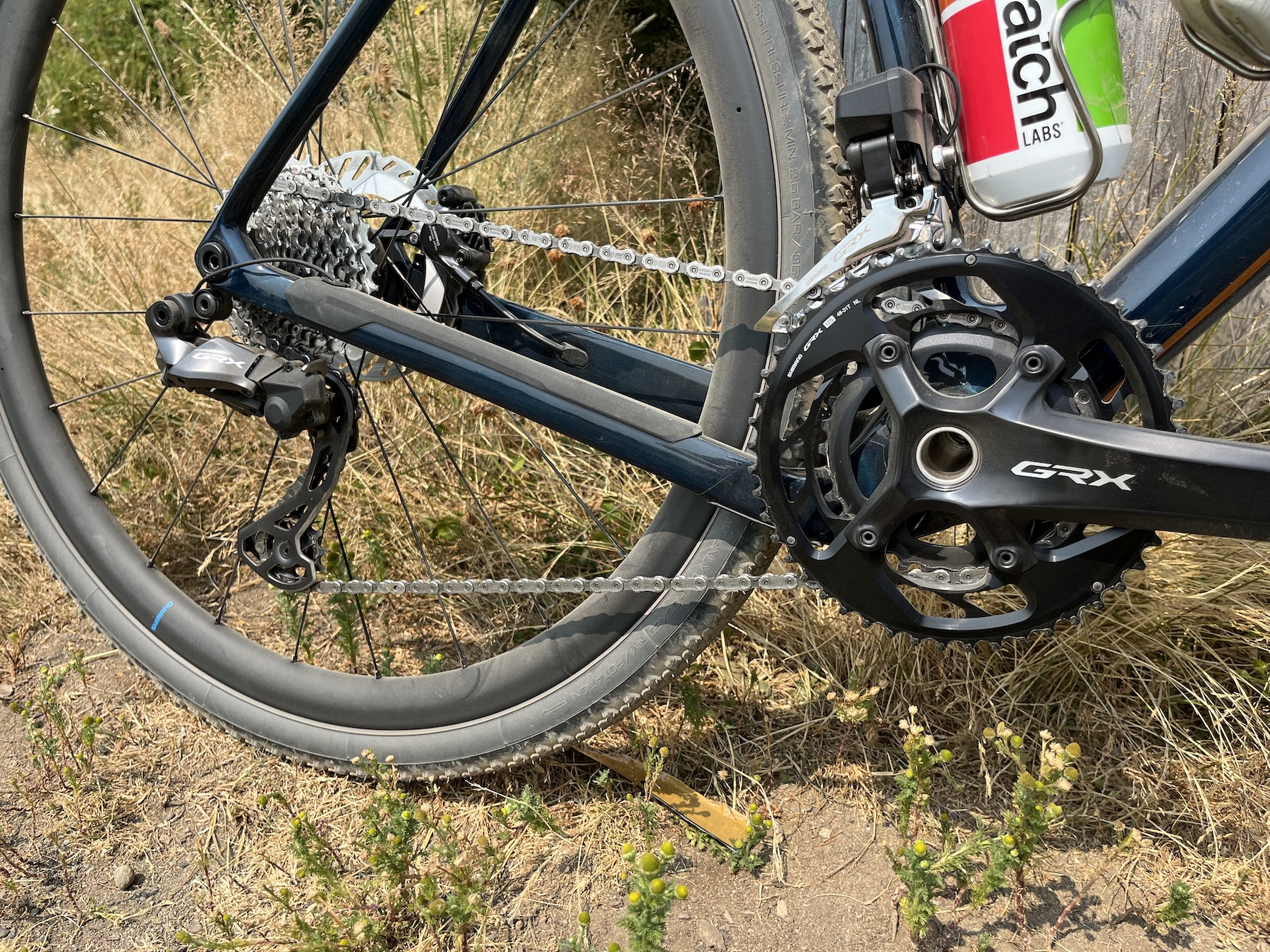
Setup
I covered setup at length in the initial Flash Review, but I was initially quite intimidated by the prospect of installing a wired electronic drivetrain, especially after hearing tales of older drop bar Di2 installations being a nightmare, with junction boxes and lots of wiring paths to deal with to interconnect everything with the battery. Fortunately, the new generation Di2 proved to be a pleasure to work on — a pleasant surprise afforded by Shimano’s inclusion of wireless shifters with the new GRX RX825 group.
Wireless brakes still aren’t a thing, though, and with headset cable routing seemingly here to stay in the Gravel and Road world, that meant a fairly comprehensive teardown of my Orbea Terra M-TEAM to get everything together. Shimano’s Road and Gravel brakes do (inconveniently) require a different bleed funnel (or bleed funnel extender) given the differently sized bleed screw relative to their MTB brakes, but trimming up the lines was straightforward otherwise. The wireless shift levers meant I was spared the task of routing any shifting cables (or wires, in this case) through the headset, and the RX825 group ultimately cleaned up my cockpit a bit.
Installing the battery in the seat tube does require a separate rubber battery holder, typically supplied by a frame manufacturer or purchased aftermarket. I was able to use a fairly generic one for a 27.2 mm seat post, but buyers will need to confirm fitment with their specific frame and seatpost arrangement. Once I had sourced one of those, it was a little bit of a pain to snake the thin and floppy Di2 wires through the seat tube and chainstay, but everything snapped together nicely at the battery and derailleurs (the included Di2 wire tool is useful here). Riders running dropper posts should be warned — the Di2 system’s reliance on the seat post mounted battery (i.e., requiring a hollow seatpost) means that running a dropper will require going off script from Shimano’s instructions to re-home the battery. Some folks may be able to get creative there, but it certainly feels like a hack-y solution for a fairly expensive drivetrain. Overall the Di2 install proved to be even slightly easier to install than a mechanical drivetrain, primarily because of the wireless shifters.
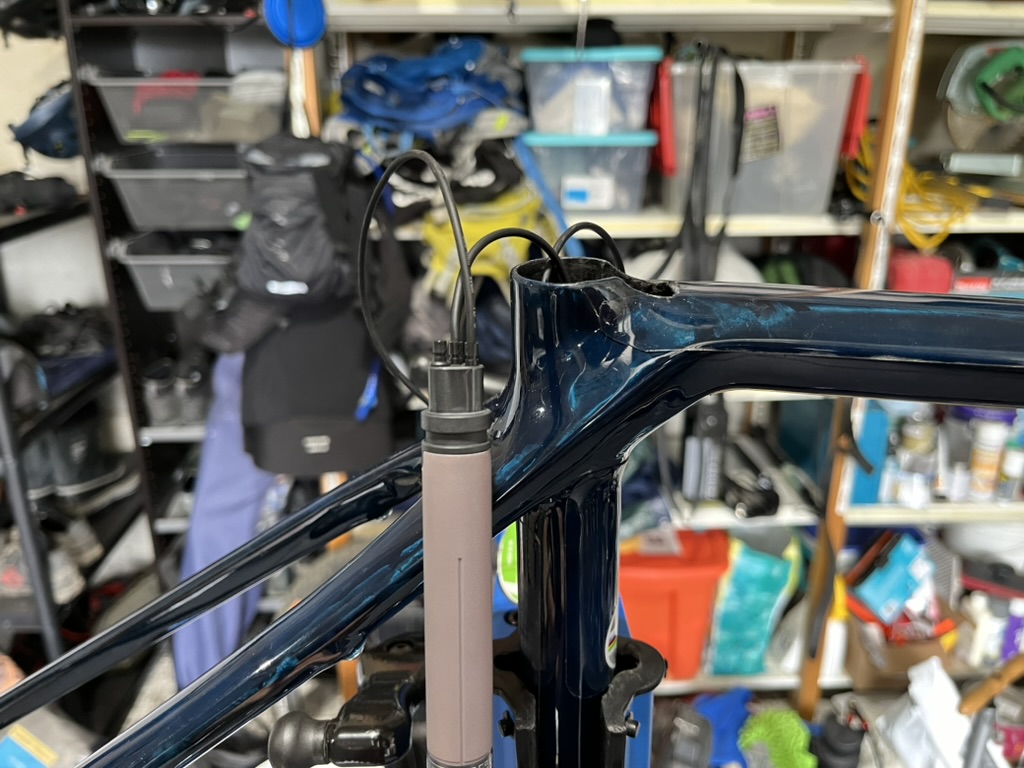
Dialing everything in is a fairly simple process, with guided steps provided in Shimano’s E-Tube app, and there’s also a wealth of online content with tips and tricks. It’s not all that dissimilar from a conventional drivetrain setup, except there is no cable tension to be dealt with — limit screws and the rear derailleur’s B-tension screw are all that really need adjustment. Within a few minutes, the front derailleur was making happy robot noises as it precisely moved the chain, and the rear derailleur indexing was dialed.
On-Trail Performance
RX825 Drivetrain
I’ve spent multiple years on Shimano’s mechanical 2 x 11 GRX RX810 drivetrain and have found it to be rock solid. Between that experience and my skepticism around electronics proliferation on bikes, I questioned how much of a performance improvement the electrified GRX RX825 drivetrain could offer. It turns out that the gains are quite compelling.
The brain of the RX825 system is the rear derailleur, which directs inputs from the shifters to the front derailleur as needed. The wired connection to the central seat tube-mounted 500 mAh BT-DN300 battery seems a little clunky compared to the truly wireless drivetrains on the market, but it’s also what affords the massive 620 miles / 1000 km of estimated battery life while only requiring that a single battery be charged. SRAM’s AXS system claims 60 hours of battery life for Road drivetrains and 25 hours for Mountain, so the Gravel use case is likely somewhere in between — despite the difficulty comparing the miles vs. hours claims from each brand, Shimano’s system seems to last a good bit longer.

The central battery’s status can be checked by tapping the button on the derailleur and checking the color of the LED — solid green means 75% or more, blinking green means 50% – 75%, solid red means 25% – 50%, and blinking red means less than 25%. Shifter battery life with the RX825 group is basically a non-issue, with the coin-cell batteries estimated to last 3.5 – 4 years.
On the trail (or road), the RX825 system largely disappears into the background. The far smaller motions required to actuate the shifter buttons are not only less awkward than a mechanical setup but also seem to lead to more precise and consistent shifts. The rear derailleur delivers fast shifts while being basically silent in use, and pressing and holding either of the shift buttons allow you to move through a bunch of gears quite quickly. The front derailleur makes quite a loud whining noise as the servo does its work, but it also shifts fairly quickly and feels far more precise than a mechanical front derailleur — not that that’s a high bar. Despite the minor annoyance of that loud front derailleur, the system feels a touch more refined and sharp than even a well-tuned mechanical drivetrain. The front derailleur also makes automatic trim adjustments in higher and lower portions of the cassette to prevent any chain interference with the front derailleur on the extreme ends of the cassette — it’s a very nice feature and something I’m happy to let be an afterthought thanks to Di2.
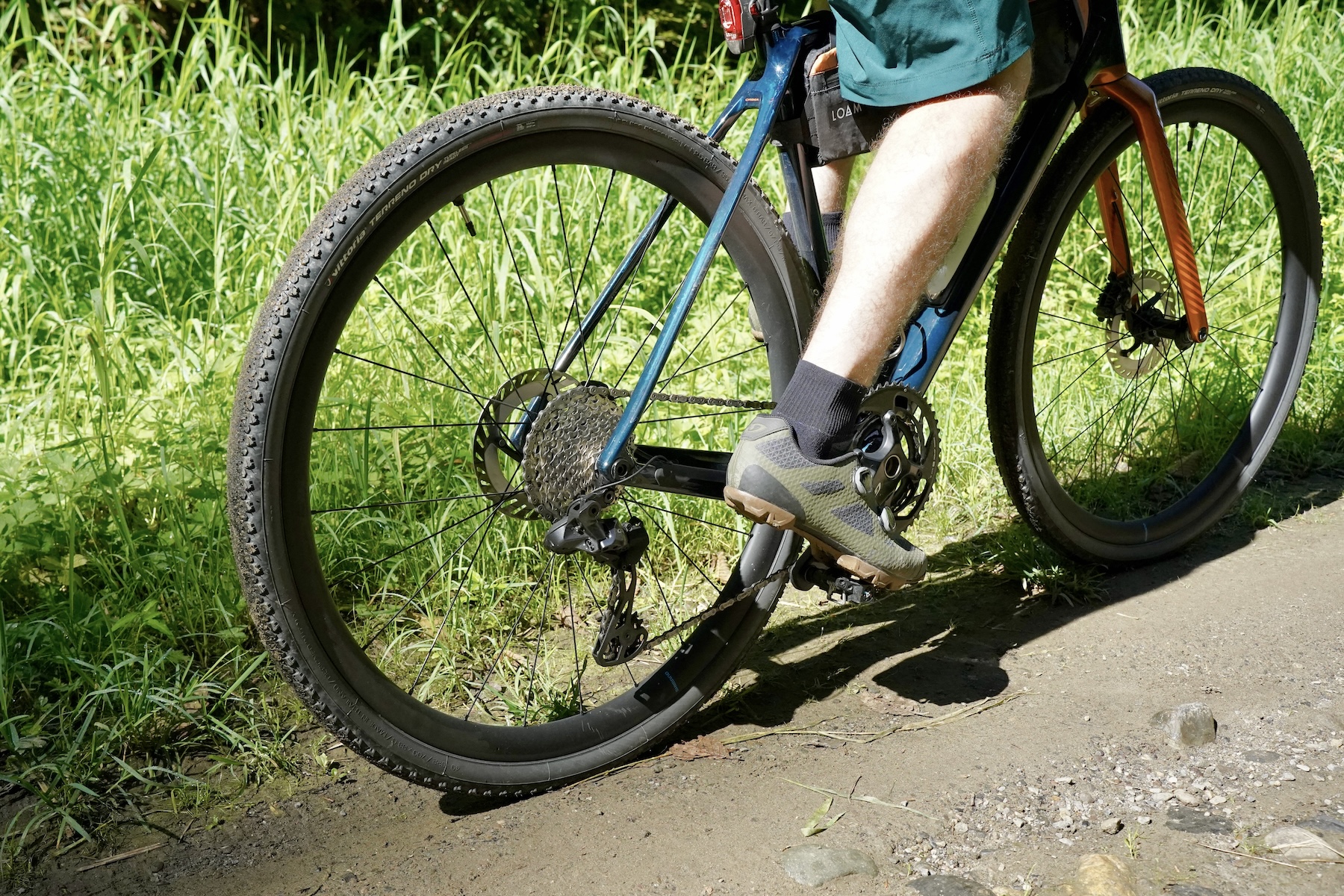
Aside from guiding you through any necessary derailleur adjustments, Shimano’s E-Tube app allows a ton of customization as far as shifting patterns go. The Front Shift Next functionality allowed me to hit whichever button on the front shifter to move the front derailleur into the other chainring rather than having dedicated up- and downshift buttons — it seems like a small thing, but it’s one less thing to think about while riding. I did experiment with the Synchronized Shift feature as well, and I quite enjoyed what Shimano calls Semi-Synchronized Shift, the rear derailleur automatically shift up or down by one or two cogs when shifting the front derailleur to make the gear ratio change feel a bit more natural. This was especially nice given the sizeable step between the 31T and 48T chainrings. The full-on Synchronized Shift option goes as far as having the front derailleur shift automatically once the rear derailleur reaches certain gears. It makes sense as far as finding the smoothest progression of gear ratios, but in practice (at least for me) a front derailleur shift is always going to feel a bit clunky. Combine that with the fact that shifting techniques are fairly hardwired into my brain, and I strongly preferred a more manual approach. Regardless of your preferences, it can all be customized in the E-Tube app, and different configurations can be saved as separate profiles to allow switching between different pre-arranged settings on a given ride.
On a final note, the GRX RX825’s 12-speed arrangement means that the drivetrain benefits from Shimano’s Hyperglide+ chain and tooth profiling. I’m well-versed in Hyperglide+ from my many experiences on Shimano’s 12-speed Mountain drivetrains, and I can confirm that the RX825 group gets the same smoother and faster shifting under power when compared to my prior RX810 11-speed setup.
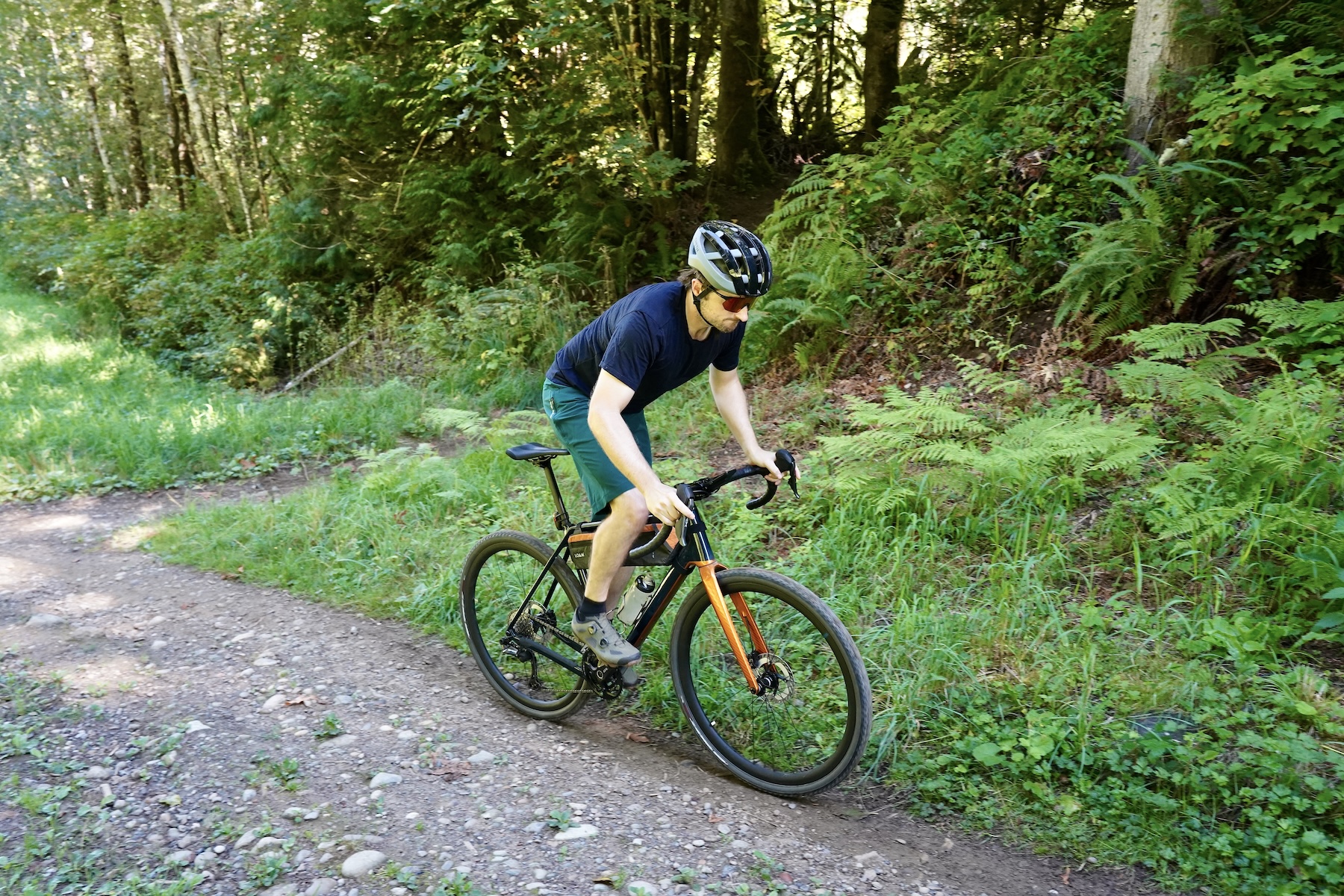
RX820 Brakes
Arriving on the scene with the mechanical 12-speed GRX RX820 drivetrain released last year, Shimano also supplied us with the updated RX820 brake caliper. The updates are fairly minimal compared to the outgoing RX810 brakes, with a claimed 10% increase in pad clearance and a fitting-based bleed port (rather than a bleed nipple) located on the outside of the caliper for easier access. Paired with 160 mm CL800 rotors, I found the RX820 calipers to offer an upgraded braking experience in just about every way. Relative to my prior RX810 calipers and MT800 rotors (also 160 mm), I found the updated caliper and rotor combo to have better piston rollback for less rubbing, far less braking noise, and slightly improved consistency and power on longer descents. Obviously, the power component may also have to do with the new RX825 lever design too, but it’s an improvement over my RX810 drivetrain.
The RX820 caliper also features black pistons, rather than the typical white pistons found on Shimano brakes. Regular readers will have picked up on our frustration with Shimano’s often leaky calipers, so while I can’t confirm whether these black pistons are an indication of a new piston material and seal combination, I’m very much hoping that’s the case.
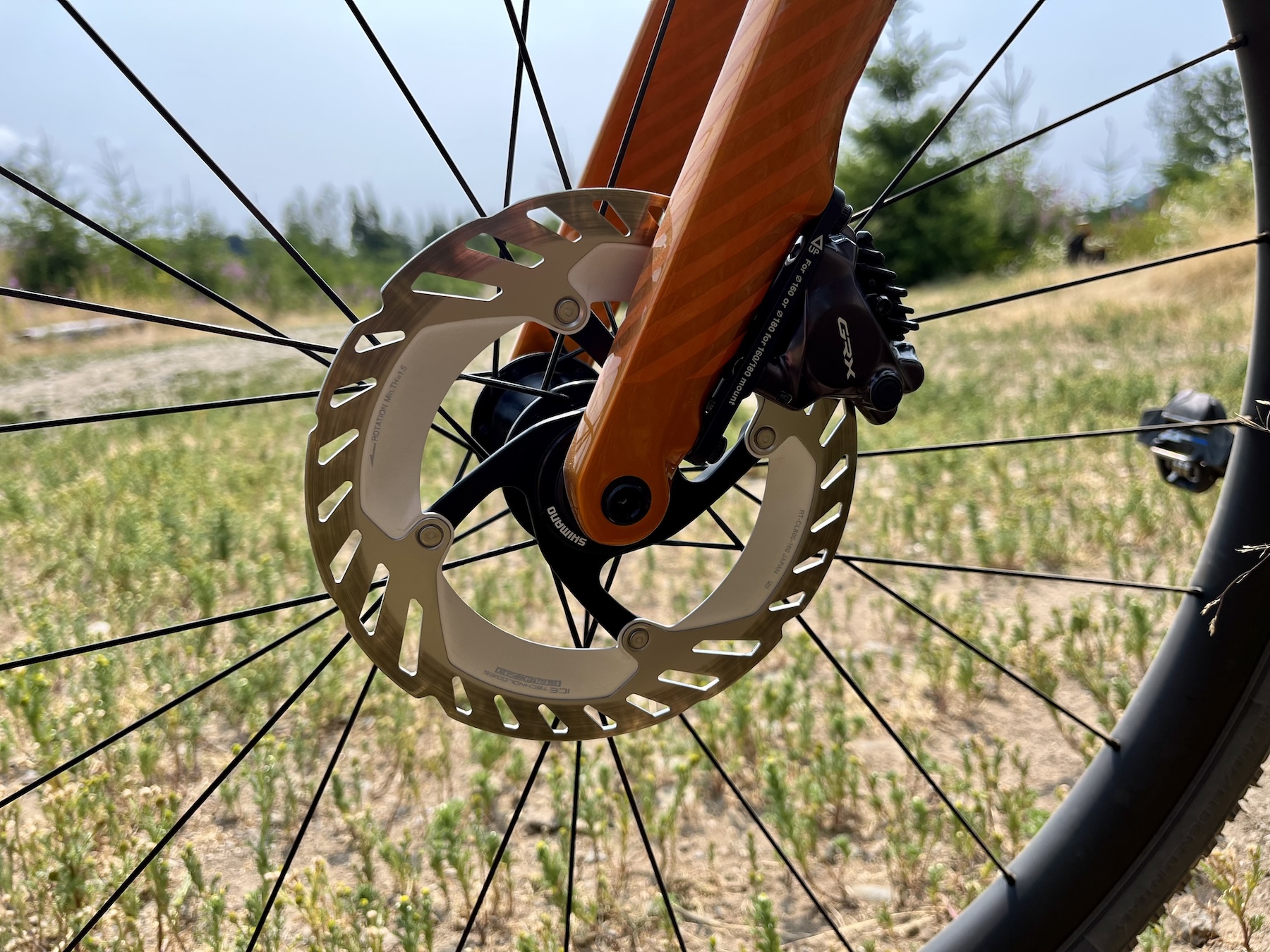
RX880 Wheels
The RX880 wheelset was released alongside Shimano’s 12-speed mechanical GRX components in 2023, but they remain Shimano’s range-topping Gravel wheel option. Featuring a relatively shallow 32 mm rim depth and 25 mm internal width (suited for 32—50 mm tires), the wheels are quite lightweight while also featuring Shimano’s Direct Engagement system adapted from their Dura-Ace wheels. Direct Engagement relies on two opposing drive rings rather than pawls, similar to DT Swiss’ ratchet system (and likely a product of that patent expiring), and is notably quiet while still offering ample engagement — Shimano doesn’t clearly indicate points of engagement in their own specifications, but I counted 50.
The wheels are fairly stiff and precise, with a bit more vibration transmission than the aluminum Vision Team Aero Gravel wheels that preceded them on my bike, but the low weight, high efficiency, and very positive-feeling engagement of the freehub give them a very refined and fast feel. I also had no issues with getting tires to mount up quickly and easily, across multiple tire swaps during the test period.
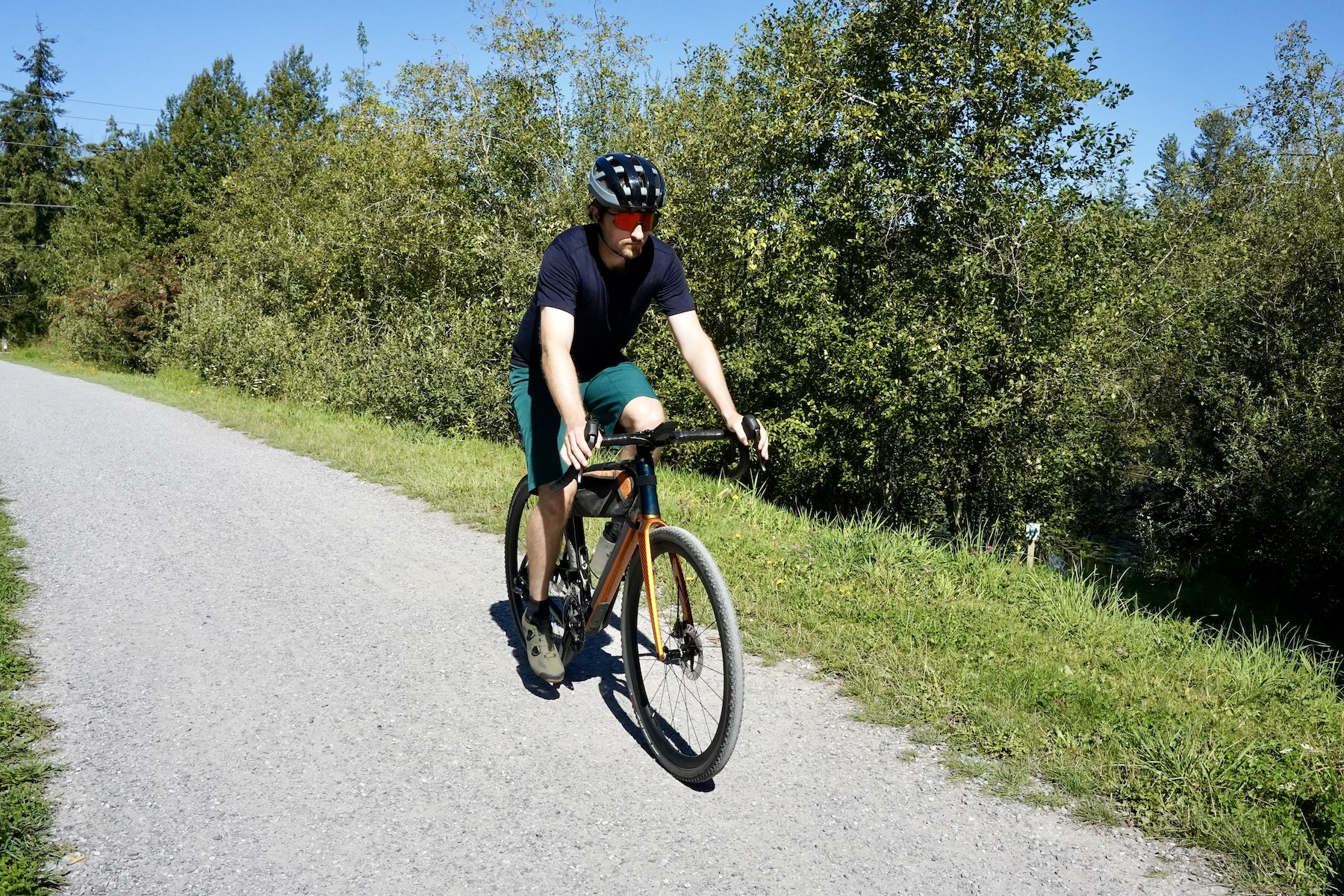
Durability and Maintenance
I’ve had no durability issues whatsoever with the GRX RX825 group. Aside from the front derailleur’s mounting screw coming loose a couple of times after being hammered along some very rough trail, I didn’t have to touch a single adjustment through hundreds of miles of ride time. Charging the system was very infrequent thanks to the large battery capacity, but charging was as simple as hooking the rear derailleur up to a USB charger via the included charging cable.
I’m a big fan of Shimano’s 12-speed Mountain drivetrains, largely for their cassette and chain lifespans and general resilience for abusive riding. With GRX now getting the same 12-speed Hyperglide+ chains and tooth profiles, I expect very, very long life out of the RX825 system as a whole before even semi-disposable items like the chain and cassette require replacement — assuming regular chain cleaning and use of quality lubricants.
The bonus item in this review was the RX880 wheelset, and despite this being my first experience with Shimano’s Direct Engagement hub design, they were a treat to ride. Between the J-bend spokes, adjustable bearing preload, and very quiet-yet-positive-feeling freehub mechanism, the wheels went about their business without any unexpected noises, and despite striking the rims on a couple of sharp rocks, they held up without complaint.
Who’s It For
I am admittedly a bit of an electronic shifting skeptic, but the Shimano GRX RX825 group changed my mind for Gravel use. The convenience of a wired central battery paired with wireless shifters makes a ton of sense, and I can say that I absolutely prefer this layout for ease of charging along with the significantly longer battery life that it affords by placing a larger battery within the frame. The smaller motions required to shift are more ergonomic, and it encourages more rapid and dynamic shifting while riding. Add on the fact that the rear derailleur is damn near silent, and it starts to sound like a system that makes sense for just about anyone who is willing to pay for the added performance.
Granted, the RX825 does keep a front derailleur, but as someone who uses my Gravel bike both on and off road, I thoroughly enjoy the additional range that a double front chainring affords. I absolutely loathe working with traditional cable-actuated front derailleurs, but the electronics make the front derailleur much more of an afterthought in both riding performance and maintenance — aside from the loud servo noise while shifting.
One potential deal breaker for some folks is the challenge of getting Di2 to play nicely with a dropper. The battery requires being nested in a hollow seat post, which unfortunately droppers are not. While some riders could potentially figure out a hack to get around this (like just dropping the battery into the seat tube wrapped in foam), it’s not the ideal solution — and it’s something that could turn some folks off as dropper posts see increasingly stronger adoption on Gravel bikes.
Long story short, I think that the GRX RX825 system is a fantastic option for just about any Gravel rider, provided that you don’t mind a dual chainring setup (or the price tag). The wireless shifters feel great and the whole system never missed a beat, whether on smooth tarmac or being bounced through dusty washboards in the woods. Sure, it’s not fully wireless, but the added battery life is such that even riders inclined to go on epically long rides won’t feel any range anxiety — and those of us who perhaps aren’t as vigilant on our charging routines won’t be as easily run out of juice either.
Bottom Line
The GRX RX825 is a genuine performance upgrade over a mechanical GRX setup in nearly all respects. It shifts faster and more efficiently than a mechanical drivetrain while being easier to live with from a maintenance perspective, too. Shimano’s use of wired connections may seem behind the times at first glance given the popularity of fully wireless shifting and droppers from another “S” brand, but the practicality of the semi-wireless arrangement deployed by Shimano makes a ton of sense in the field.
